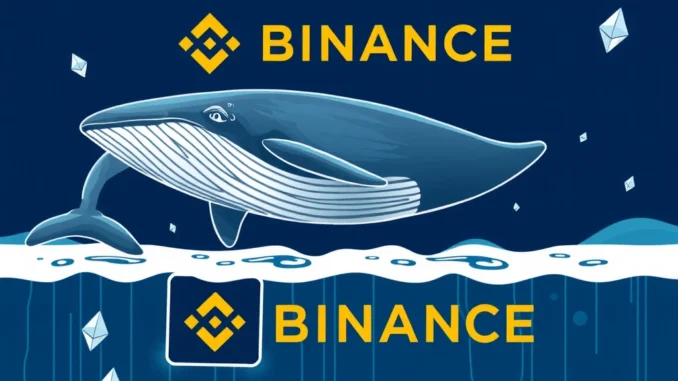
In a stunning turn of events in the cryptocurrency market, a major whale has reportedly incurred a substantial loss of $6.62 million by depositing 5,000 ETH into the popular crypto exchange, Binance. This intriguing transaction, spotlighted by on-chain analytics platform Onchain Lens, has sent ripples through the crypto community, raising questions about whale behavior and market volatility. Let’s delve into the details of this significant Ethereum movement and explore what it means for the broader crypto landscape.
Decoding the Whale Transaction: A Deep Dive into Ethereum Deposits
The recent activity of this crypto whale offers a fascinating glimpse into the high-stakes world of large-scale cryptocurrency transactions. According to data from Onchain Lens, the whale moved 5,000 ETH, valued at approximately $9.46 million at the time of deposit, into their Binance account. This deposit came after holding the ETH for a mere 15 days. But what makes this transaction particularly noteworthy is the staggering $6.62 million loss realized by the whale. To truly understand the magnitude of this event, let’s break down the key elements:
- Initial Withdrawal: Prior to this deposit, the whale had withdrawn a significant 10,000 ETH from the derivatives exchange Deribit. At the time of withdrawal, this amount was valued at a hefty $25.6 million.
- Current Holdings: Despite the recent deposit and loss, the whale still maintains a considerable balance of 5,000 ETH, currently valued at around $9.51 million. This indicates the whale’s continued, albeit potentially adjusted, position in the Ethereum market.
- Timeline Matters: The 15-day holding period is crucial. It suggests a relatively short-term strategy or perhaps a miscalculation of market movements during this period.

[caption]Visual representation of a whale icon moving Ethereum coins into a Binance exchange interface.
[/center>
Why the Loss? Unpacking the $6.62 Million Crypto Loss
The burning question on everyone’s mind is: how could a seasoned whale incur such a massive crypto loss? Several factors could contribute to this financial setback. Understanding these potential reasons can provide valuable insights into the risks and complexities of cryptocurrency trading, even for the most experienced players.
- Market Volatility: The cryptocurrency market is notorious for its extreme volatility. In a span of 15 days, significant price fluctuations can occur. It’s possible that the whale anticipated a market uptrend that did not materialize, or conversely, a sudden downturn caught them off guard.
- Trading Strategy Gone Wrong: Whales often employ sophisticated trading strategies. This particular transaction might have been part of a larger, more complex strategy that, for unforeseen reasons, did not play out as expected. Perhaps it was a hedging strategy, an arbitrage attempt, or simply a directional bet gone awry.
- Timing of Deposit: The timing of the Ethereum deposit into Binance could be a critical factor. If the deposit coincided with a local price dip, and the whale sold shortly after at a lower price than their acquisition cost, a loss would be inevitable.
- External Market Factors: Broader economic events, regulatory news, or unexpected announcements within the crypto space can trigger rapid price movements. These external factors could have negatively impacted Ethereum’s price during the whale’s 15-day holding period.
Binance Exchange and Whale Activity: What’s the Connection?
Binance exchange, as one of the world’s largest cryptocurrency exchanges, is a frequent destination for whale transactions. Exchanges like Binance provide the liquidity and infrastructure necessary for whales to execute large trades. Here’s why Binance is often a hub for significant crypto movements:
| Feature | Relevance to Whales |
|---|---|
| High Liquidity | Enables whales to buy and sell large volumes of cryptocurrency without causing significant price slippage. |
| Variety of Trading Pairs | Offers numerous trading pairs, allowing whales to diversify their holdings and execute complex trading strategies across different cryptocurrencies. |
| Advanced Trading Tools | Provides sophisticated trading tools and order types that are essential for whales managing large portfolios and executing precise trades. |
| Strong Security | Offers robust security measures, which are paramount for whales entrusting large sums of assets to an exchange. |
The fact that the whale chose to deposit ETH into Binance suggests that the exchange remains a preferred platform for large crypto holders, despite the inherent risks of market fluctuations.
Analyzing Whale Behavior: Implications for the Ethereum Market
Understanding whale behavior is crucial for anyone involved in the cryptocurrency market, particularly in Ethereum. Whale transactions can often be leading indicators of market trends or shifts in sentiment. What can we infer from this particular whale’s actions?
- Potential Market Correction: A whale realizing a significant loss, even if unintended, could indicate broader market corrections or downward pressure on Ethereum. It might signal that even large holders are finding it challenging to navigate the current market conditions.
- Profit-Taking or Portfolio Rebalancing: While a loss is reported, it’s also possible this move was part of a larger portfolio rebalancing strategy. Whales frequently adjust their holdings across different assets to manage risk and optimize returns. This ‘loss’ might be offset by gains elsewhere in their portfolio.
- Impact on Retail Investors: Whale transactions can influence market sentiment and potentially trigger reactions from retail investors. News of a large loss might create fear, uncertainty, and doubt (FUD), leading to further selling pressure, or conversely, it could be seen as an isolated event with minimal long-term impact.
Key Takeaways: Lessons from this Whale’s Ethereum Trade
This incident serves as a stark reminder of the volatile nature of cryptocurrency markets and the inherent risks involved, even for seasoned participants like whales. Here are some crucial takeaways:
- Risk Management is Paramount: Even with substantial capital and sophisticated strategies, losses are still possible in the crypto market. Robust risk management strategies are essential for all investors, regardless of portfolio size.
- Due Diligence and Market Awareness: Staying informed about market trends, potential risks, and external factors influencing cryptocurrency prices is crucial for making informed trading decisions.
- Volatility is Inherent: Cryptocurrency markets are inherently volatile. Investors must be prepared for rapid price swings and understand that losses can occur even in seemingly well-planned trades.
- Whale Movements Matter: Tracking whale transactions can provide valuable insights into market dynamics, but it’s important to interpret these movements within a broader context and avoid making impulsive decisions based solely on whale activity.
In conclusion, the story of this whale’s $6.62 million Ethereum loss on a Binance deposit is a powerful example of the risks and rewards inherent in the cryptocurrency world. It underscores the importance of vigilance, strategic planning, and robust risk management for all participants in this dynamic and often unpredictable market. As the crypto landscape continues to evolve, understanding these events and learning from them will be key to navigating its complexities and achieving long-term success.



